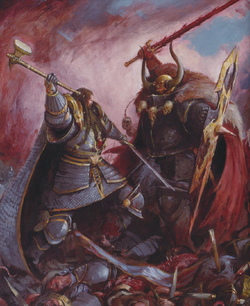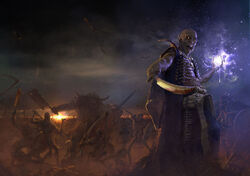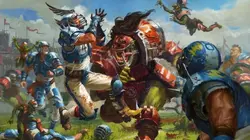
In one alternate timeline of the Known World remembered as the Storm of Chaos, Archaon the Everchosen failed in his quest to bring about the End Times and destroy the mortal world.
The Warhammer universe possesses several different alternate timelines. This article helps readers navigate between them.
Storm of Chaos[]
The Storm of Chaos (2521-2522 IC) was the name later given to the greatest assault launched by the servants of Chaos upon the Old World, when Archaon the Everchosen and the forces of Chaos sought to conquer first Kislev and the Empire, and then the rest of the continent. Archaon was thwarted in this attempt by the valiant efforts of the Men of the Empire, and the End Times were averted, at least temporarily, in this now non-canon timeline.
Age of Reckoning[]
The Age of Reckoning timeline takes place in the aftermath of a great plague when the Empire, the Dwarfs, and the High Elves joined forces to battle Chaos, the Dark Elves and the Greenskins. In this timeline neither the Storm of Chaos nor the End Times ever happened.
The End Times[]
The End Times (2519 - 2528 IC) is the great cataclysmic apocalypse that was predicted to bring about the end of the mortal world. It was heralded by the arrival of the Twin-Tailed Comet in 2519 IC, both an omen of hope and one of destruction.
The comet signaled the coronation of the thirteenth Everchosen of Chaos Undivided: Archaon the "Three Eyed King," the "Lord of the End Times," and his bid to bring destruction upon all the realms of Men in the Old World. As the world endured its final, agonising demise, the mortal races of the Old World fought valiantly to the very last against the encroaching darkness which sought to consume them all.
Unfortunately, despite their great efforts, the peoples of the mortal world failed to stem the tide of Chaos and the Known World was destroyed as the full power of Chaos was finally unleashed and unmade all creation.
Further non-canon information providing alternative endings to the End Times can be found here: Alternative End Times Timelines.
Guardians of the Forest[]
Leofric Carrard came out of Athel Loren 100 years after he first entered due to the time dilation effects that plagued many of those who entered that magical forest. He emerges to meet his own great grandson who is himself an old man and the lord of Castle Carrard in around the year 2622 IC, long after the world was already consumed by the End Times in the primary timeline. This means that this alternate timeline takes place farther in the future than any of the others in the Warhammer universe.[3]
Zavant[]
The novel Zavant by Gordon Rennie tells of a time in the year 2604 IC where the Known World has not met its end almost a century earlier, but rather where the mortal races continue to ignore the same threats to their still extant civilisations such as those presented by the Tomb Kings and the Skaven.[2]
Total War: Warhammer[]
The three computer games of the Total War: Warhammer franchise take place in a somewhat different variant of the Warhammer Fantasy Battle universe, and includes several canonical changes made for gameplay reasons such as the continued existence of characters like Repanse de Lyonesse into the early 26th century IC, and a different Elector Count lineup for the Empire during the election of Karl Franz as emperor that is identical to that following the Turmoil of 2512 IC rather than the one canonically present before that short Imperial civil war.[4][5]
The games also had narrative campaigns in Total War: Warhammer II and Total War: Warhammer III which included the possibility of outcomes never explored in the original canon timeline, such as the Horned Rat, the minor Skaven Chaos God, entering the mortal world through the Great Vortex and the Kislevite bear god Ursun being chained by the Daemon Prince Be'lakor in the Forge of Souls.[5][6]
Warhammer Fantasy Battle 1st, 2nd, and 3rd Editions[]
The lore of the Known World changed dramatically after the release of the 4th Edition of Warhammer Fantasy Battle. Before that, Bretonnia was ruled by a different king, Charles de la Tête d'Or III, who was replaced with Royarch Louen Leoncoeur, and the Bretonnian capital of Oisillon was moved to Castle Brionne. Bretonnian society in that alternate timeline was falling into ruin, as a national apathy had set in and given rise to corruption, inefficiency, and decay. The Bretonnian aristocracy looked only to its own pleasures while the unruly mob of peasants starved amidst the worst squalor in the Old World.[8a]
In the Empire, The Enemy Within campaign of Warhammer Fantasy Roleplay 1st Edition proposed a different scenario from the one described in The Enemy Within of Warhammer Fantasy Roleplay 4th Edition, where the Turmoil of 2512 IC and the changes it wrought upon the makeup of the Empire's Electoral Provinces and high nobility never happened.[1a][8a]
In Warhammer Fantasy Roleplay 1st Edition: Death's Dark Shadow, Emperor Karl Franz was assassinated. Sigmarite and Ulrican factions waged a civil war against each other following the death and a new emperor, Heinrich I, a sympathiser of the Cult of Ulric, was placed on the throne of the Empire by the victorious Ulricans.[1a]
Each of these changes occurred and were consistent within the same timeline that was erased following the introduction of the 4th Edition of Warhammer Fantasy Battle.
Warhammer Fantasy Roleplay 3rd Edition[]
Much of the lore of Warhammer Fantasy Roleplay 3rd Edition takes place in a continuity that combines parts of the Storm of Chaos timeline (such as the fall of Miragliano)[9a], with events from the End Times timeline (such as the victory of Surtha Lenk at Kislev[10a], as well as the events in Ubersreik leading up to the plot of the video game Warhammer: The End Times - Vermintide[11a]).
Time of Legend Novels[]

The Vampire Lord W'soran, founder of the Necrarch bloodline of Vampires, as depicted in the novel Master of Death.[12a]
The Time of Legend prequel novels all recount legendary events from the history of the Known World of Mallus. The canonicity of the events depicted in these books is always questionable and often conflicts with prior established lore. Even the series' authors have admitted that several conflicts in canon arose due to the lack of true coordination between the various projects. As Mike Lee, one of the Time of Legend authors noted, "these legends are just that -- dimly remembered tales of a long-forgotten age."[13]
Age of Sigmar[]
Warhammer Age of Sigmar is the spiritual and canonical in-universe successor to the Warhammer Fantasy Battle and Warhammer Fantasy Roleplay universes, after the setting was discontinued by Games Workshop in 2015 and fictionally destroyed by Chaos during the End Times.
Due to this change, Warhammer Age of Sigmar contains many of the same characters, themes, and models as its predecessor and canonically directly follows on from the events and timeline of the End Times, though many aeons later. In the Mortal Realms of the Age of Sigmar the world of Mallus is remembered only as the "World-That-Was," though many of its greatest mortal heroes have been reincarnated in new forms or as Ascended deities like Sigmar and Nagash.
Blood Bowl[]

The Blood Bowl tabletop game is set in a humorous, completely non-canonical alternate timeline of the Known World in which brutal games replace warfare as the primary form of conflict in the Old World due to the influence of Nuffle, the god of violent sports.[7]
The Blood Bowl began during a battle between Dwarfs and Orcs, when they stumbled across an ancient arena and found the rules for a religious rite dedicated to the god Nuffle. One of the Dwarfs translated the ancient tome and the two armies used the rules of the rite to settle their conflict. The result was the birth of the Blood Bowl![7]
The Dwarf translator took the name of Roze-El and became the first commissioner of the NAF as teams were created across the Known World to participate in the new sport. The Cabalvision networks began to broadcast games, and within a few years, no one cared about going to war anymore -- just winning at Blood Bowl![7]
Sources[]
- 1: Warhammer Fantasy Roleplay 1st Edition: Death's Dark Shadow (RPG)
- 1a: pg. 33
- 2: Zavant (Novel) by Gordon Rennie
- 3: Guardians of the Forest (Novel) by Graham McNeill.
- 4: Total War: Warhammer (PC Game)
- 5: Total War: Warhammer II (PC Game)
- 6: Total War: Warhammer III (PC Game)
- 7: Jim & Bob present the History of Blood Bowl
- 8: Warhammer Fantasy Battles (3rd Edition)
- 8a: pp. 200-201
- 9: Warhammer Fantasy Roleplay 3rd Edition: The Player's Guide (RPG)
- 9a: pg. 134
- 10: Warhammer Fantasy Roleplay 3rd Edition: The Enemy Within (RPG)
- 10a: pg. 64
- 11: Warhammer Fantasy Roleplaying 3rd Edition: The Edge of Night (RPG)
- 11a: pg. 64
- 12: Time of Legend: Master of Death (Novel) by Josh Reynolds
- 12a: Cover
- 13: Ask the Author: Mike Lee (Article)
